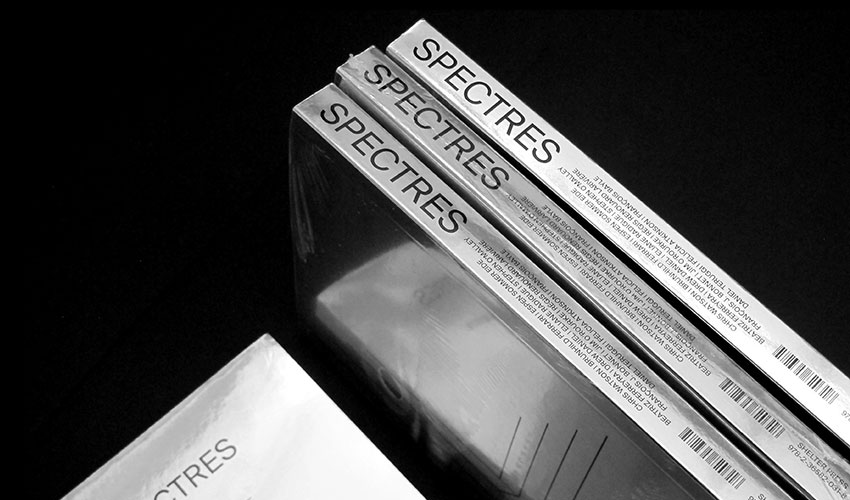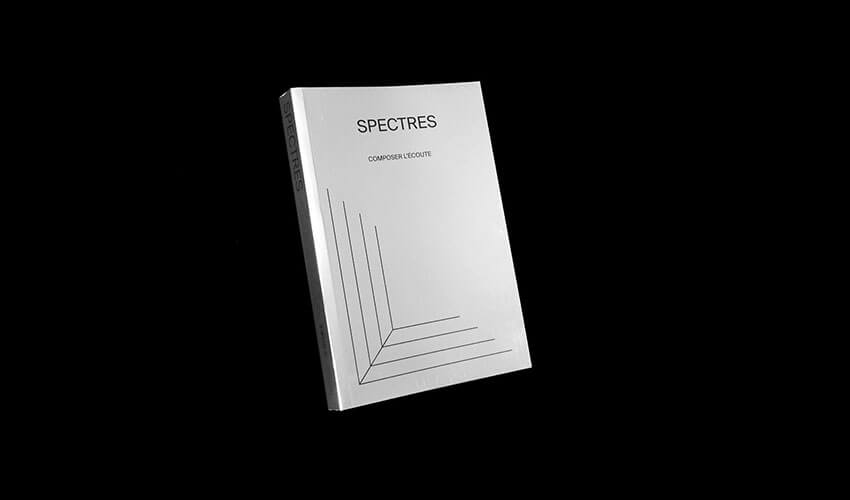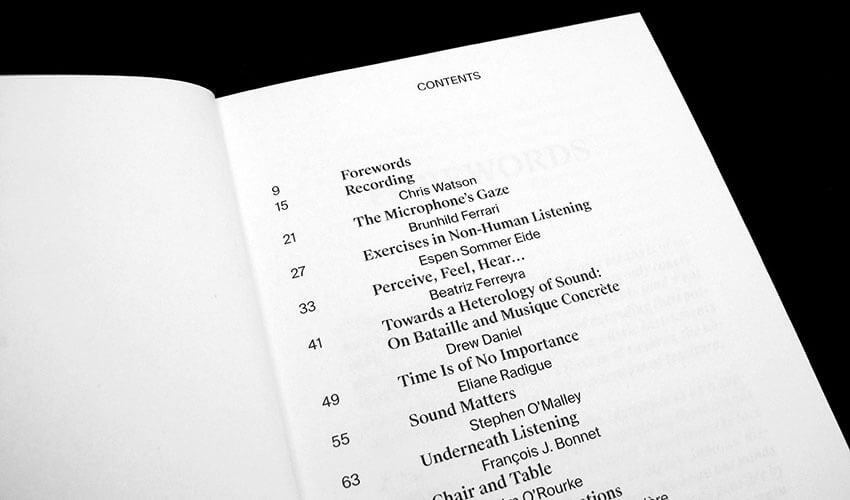Text by Daniel Mackenzie

The recently published title Spectres, issued through French imprint Shelter Press, unveils some of the mysteries threaded through compositional techniques followed by experimental musicians and sound makers. With the subtitle Composer l’écoute, we’re perhaps led to assume that the creative passage is, in this case, driven by process rather than result, a propelled and pensile swing between internal decisiveness and external experience happening in real-time.
This collection has been compiled by François J. Bonnet (INA GRM) & Bartolomé Sanson (Shelter Press) and is described by them as ‘both a prism and a manual’. We are, it is implied, encouraged to treat the insights as an exposure to the foundations and anatomy of experimental music whilst allowing ourselves to be inspired and invigorated in our own sonic practice and experience.
The book features contributions from diverse sound practitioners, including modular pioneer Éliane Radigue, field recording specialist Chris Watson and Shelter Press’s master of abstract modern composition Felicia Atkinson. Each of these figures offers their personal take on creating sound and music, the philosophies and psychologies that underpin decisions and the assessment of outcomes.
Spectres: Composer l’écoute is the first of a series of publications that will return annually, with each new edition concentrating on a different theme. On an introductory page of the book, a sequence of words spells out the components of electroacoustic composition plainly and directly: listen, record, compose, deploy, feel. This elegantly constructs the framework on which the subsequent written accounts rest, emphasising each element shifting as the book is explored.
Daniel Teruggi’s Spaces of Mind reminds us of our powerful capabilities for acoustic sound location – our ability to understand the parameters of a space and objects within it through a detailed and intuitive perception of physical sonic interactions. Our behaviours are influenced by this perception, and the composer’s work is inextricably linked to and influenced by the attributes of the recording and listening space, the interior acoustic environment of instruments and the resonant qualities of materials. It is too easy to forget that the listening experience, even of recorded sound, is a result of such intricacy, a restless and endlessly pliable network of relationships.
Espen Sommer Eide’s gentle critique of human focused listening describes a situation in which a composer might take on the hearing of a mosquito, an inverted process of understanding sound frequencies designed to track the movements of a mate: we pick out tonal signals and discard the noise. The mosquito tunes into the noise and discards the signal.
In On the Patio: The Voice, Doubt, Perspective and Immersion, Felicia Atkinson delves into a more personal relationship with sound, revealing a surreal metaphysical and psychedelic landscape strewn with sonic debris and symbolism. Advancing toward a poetic examination of the voice – a key component in her material – as a tool for audio world-making, the essay becomes almost spell-like: In using the voice, I pass a silk scarf through the lock, turning the text from interior to exterior, before it slips once again into the ear of the listener. François and Bartolomé were on hand to offer some deeper reflections on the origins of the Spectres series and this first edition.


How does the inception of the Spectres series come about? And how does it relate to your practice and interests?
François J. Bonnet: As a musician, a theoretician, the idea of launching a reflexive series about music and sound composition was something I wanted to do for a long time. Taking over as head of INA GRM early 2018 helped me to materialize it. I talked to Bartolomé and Félicia from Shelter Press and I think it was a good timing for them as well, a nice way to extend their range towards more theoretical books.
Bartolomé Sanson: Indeed, and after publishing art books on one hand and records on the other for years, we were looking to finds ways to fill the gap and build bridges between the two sides of the imprint. Spectres was a dream project to do this and gave a great impulse to our publishing program for the next years.
What are your main aims behind Spectres? Do you see it also as a personal space for research and exploration?
François J. Bonnet: Personally, my goal was/is double: 1) re-affirming that a reflexive approach on musical works doesn’t need to be boring, patronizing or authoritative, but on the contrary be inspiring, generous and stimulating, and 2) offering a platform to great artists and thinkers in a form that was sometimes unusual for them: very condensed texts that reveal some key aspects of their works, or even a world view underlying their music.
Bartolomé Sanson: It is definitely a space for exploration as a reader. The book builds a reflexive space as soon as you dive into it, and each contribution adds up and creates this exciting constellation of voices. We are currently working on the second issue, and every new piece we receive enlightens a bit more than the previous ones.
Apart from the high-quality written content, we can see the design of the first book is incredibly beautiful, and these will be annual publications; to me, they feel like you’re treating these editions as special pieces where great care is taken in their construction, feeling almost like a collector’s item. What do you want to bring to your readers with these books?
François J. Bonnet: Great care in the publication is something very much in the DNA of Shelter Press. That’s also why I approached them. This care is sensible to readers and, I think, “illuminates” the texts. A beautiful, well-produced book shows the respect we have for the contributions of the artists and is kind of a signal to the reader, an invitation to read it with great care and involvement too. Texts are short, but they reveal so much.
Bartolomé Sanson: It’s also about finding the right tuning for the book. A certain piece of music needs to be played at the right level to be fully appreciated, and it is a bit the same with short texts, as we have in Spectres. You need to find a good balance in the layout to create enough space and time for the reader to embrace each contribution as a unique entity and see the collection of texts as a whole and unique project. Working on an annual publication that will stay the same over the years is exciting. You have to make choices that will stay relevant for yourself in (many) years.
The first publication, Composing Listening, revolves around matters of classical composition and the real meaning of experimental music. It reflects on the commodification of the “experimental music” genre these days when, in many instances, the “experimental” is quite far from pushing boundaries and breaking rules. Why do you think this commodification exists? Do you think it relates to the technology we are surrounded by, or is it more to do with evolving human behaviour?
François J. Bonnet: It’s a tricky question. But for sure, Technology and human behaviour are strongly interleaved, of course. But I still defend this word “experimental”, because it really underlines that this type of music, or this way of thinking music, is always driven by an experimental will with an uncertain outcome and possible failures. It’s an adventure.
Bartolomé Sanson: As you can see it reflecting in many contributions in the book, it is a personal quest that is experimental in many aspects of the composer’s relationship to the world.
You make a reflection in the preface that the book also hopes to give a new prism to the readers in grasping the essence of a world ‘that is increasingly inaccessible, dissimulated by all the procedures that tell us how to look at it, how to listen to it, how to describe it, and how to feel it’. With this in mind, how do you now cope with information and digital/screen overload?
François J. Bonnet: I personally addressed this question in a book, Après la mort, which will be translated next year, and is very much about the anaesthesia produced by the perpetual synchronization through digital networks. One track I follow in this text is, roughly, that the hyper-present is strongly linked to the denial of death. Accepting it, embracing our own duration, and acknowledging our life-span is maybe a way not to forget ourselves in the everlasting presence of live feeds.
The book is a compendium of essays by renowned musicians and artists such as Stephen O’Malley, Jim O’Rourke, Eliane Radigue, and Chris Watson. How did the editorial process work? Did you commission specific pieces or allow the writers greater freedom?
François J. Bonnet: Most of the time, we came up with a very precise idea, and after we really tried to live the author’s freedom within this very narrow angle we gave them. And almost every time it worked admirably.
Bartolomé Sanson: Francois has a way to open a door to each contributor in a really specific manner, with just enough space so that everyone has enough room to write without any constraints, but with a very specific idea in the background always leading them in the right direction.
What can we expect for the next edition?
Resonances.
Website https://shelter-press.com/spectres-1/
(Media courtesy of Shelter Press)






